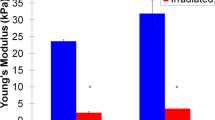Abstract
A significant logistic factor as to the successful clinical application of the autologous tissue engineering concept is efficient transportation: the donor cells need to be delivered to tissue processing facilities which in most cases requires air transportation. This study was designed to evaluate how human chondrocytes react to X-ray exposure. Primary cell cultures were established, cultured, incubated and exposed to different doses and time periods of radiation. Subsequently, quantitative cell proliferation assays were done and qualitative evaluation of cellular protein production were performed. Our results show that after irradiation of chondrocytes with different doses, no significant differences in terms of cellular viability occurred compared with the control group. These results were obtained when chondrocytes were exposed to luggage transillumination doses as well as exposure to clinically used radiation doses. Any damage affecting cell growth or quality was not observed in our study. However, information about damage of cellular DNA remains incomplete.


Similar content being viewed by others
Abbreviations
- DMEM:
-
Dulbecco’s modified essential medium
- ECM:
-
Extracellular matrix
- FCS:
-
Fetal calf serum
- MTT:
-
3-(4,5-Dimethyl-2-thiazolyl)-2,5-diphenyl-2H- tetrazolium bromide
- PBS:
-
Phosphate-buffered saline
References
Cima LG et al (1991) Tissue engineering by cell transplantation using degradable polymer substrates. J Biomech Eng 113:143
Langer RS, Vacanti JP (1999) Tissue engineering: the challenges ahead. Sci Am 280:86
Langer RS, Vacanti JP (1993) Tissue engineering. Science 260:920
Hunziker EB (2002) Articular cartilage repair: basic science and clinical progress. A review of the current status and prospects. Osteoarthritis Cartilage 10:432
Hunziker EB (2000) Articular cartilage repair: problems and perspectives. Biorheology 37:163
Vacanti JP, Langer R (1999) Tissue engineering: the design and fabrication of living replacement devices for surgical reconstruction and transplantation. Lancet 354:132
Oakes BW (2004) Orthopaedic tissue engineering: from labaratory to the clinic. MJA 180:35
Sowby FD (1980) Statement and recommendations of the international commission of radiological protection from its 1980 meeting. Radiology 136:239
Vock P, Valley JF (2004) Medizinische Strahlenexposition in der Schweiz- Teil 1: Frequenzen, Dosen, Konsequenzen. Swiss Medical Forum 34:845
Rothkamm K, Löbrich M (2003) Evidence for a lack of DNA double-strand break repair in human cells exposed to very low X-ray doses. Proc Natl Acad Sci USA 29:5057
Ogawa Y, Takahashi T et al (2003) Comparison of radiation-induced reactive oxygen species formation in adult articular chondrocytes and that in human peripheral T cells: possible implication in radiosensitivity. Int J Mol Med 11:455
Löbrich M, Rief N, Kuhne M, Heckmann M, Fleckenstein J, Rube C, Uder M (2005) In vivo formation and repair of DNA double-strand breaks after computed tomography examinations. Proc Natl Acad Sci USA 21:8984
Mosmann T (1983) Rapid colorimetric assay for cellular growth and survival: application to proliferation and cytotoxicity assays. J Immunol Methods 65:55
Zünd G, Ye Q, Hoerstrup SP, Schoeberlein A, Schmid AC, Grunenfelder J, Vogt P, Turina M (1999) Tissue engineering in cardiovascular surgery: MTT, a rapid and reliable quantitative method to assess the optimal human cell seeding on polymeric meshes. Eur J Cardiothorac Surg 15:519
Koch RJ, Gorti GK (2002) Tissue engineering with Chondrocytes. Facial Plast Surg 18:59
Mandl EW, Van der Veen SW, Verhaar JAN, Van Osch GJVM (2004) Multiplication of human chondrocytes with low seeding densities accelerates cell yield without losing redifferentiation capacity. Tissue Eng 10:109
Damron AD, Margulies BS, Strauss JA, O`Hara K, Spadaro JA, Farnum CE (2003) Sequential histomorphometric analysis of the growth plate following irradiation with and without radioprotection. J Bone Joint Surg Am 85:1302
Kamil S, Rodrigruez A, Vacanti CA, Eavey RD, Vacanti MP (2004) Expansion of the number of human auricular chondrocytes: recycling of culture media containing floating cells. Tissue Eng 10:139
Takahashi T, Mizobuchi H, Toda M, Maeda A, Mizuno S, Ogawa Y, Yoshida S, Yamamoto H (2003) Metabolic effects of X-ray irradiation on adult human articular chondrocytes. Int J Mol Med 11:631
Jikko A, Hiranuma H, Iwamoto M, Kato Y, Okada Y, Fuchihata H (1996) Effects of X irradiation on metabolism of proteoglycans. Radiat Res 146:93
Hiranuma H, Jikko A, Iwamoto M, Fuchihata H (1996) Effects of X-ray irradiation on terminal differentiation and cartilage matrix calcification of rabbit growth plate chondrocytes in culture. Bone 18:233
Ryan A, Bertone AL, Kaeding CC, Backstrom KC, Weisbrode SE (2003) The effects of radiofrequency energy treatment on chondrocytes and matrix of fibrillated articular cartilage. Am J Sports Med 31:386
Acknowledgments
We owe special gratitude to the employees of the Police Department at Zurich International Airport, particularly to Mr. Wuest, who supported us very kindly both in the planning and the execution phase of our experiments. Likewise, we thank SwissLife for supporting our study.
Author information
Authors and Affiliations
Corresponding author
Rights and permissions
About this article
Cite this article
Koehler, C., Niederbichler, A.D., Scholz, T. et al. Should human chondrocytes fly? The impact of electromagnetic irradiation on chondrocyte viability and implications for their use in tissue engineering. Bioprocess Biosyst Eng 29, 415–420 (2006). https://doi.org/10.1007/s00449-006-0094-8
Received:
Accepted:
Published:
Issue Date:
DOI: https://doi.org/10.1007/s00449-006-0094-8




